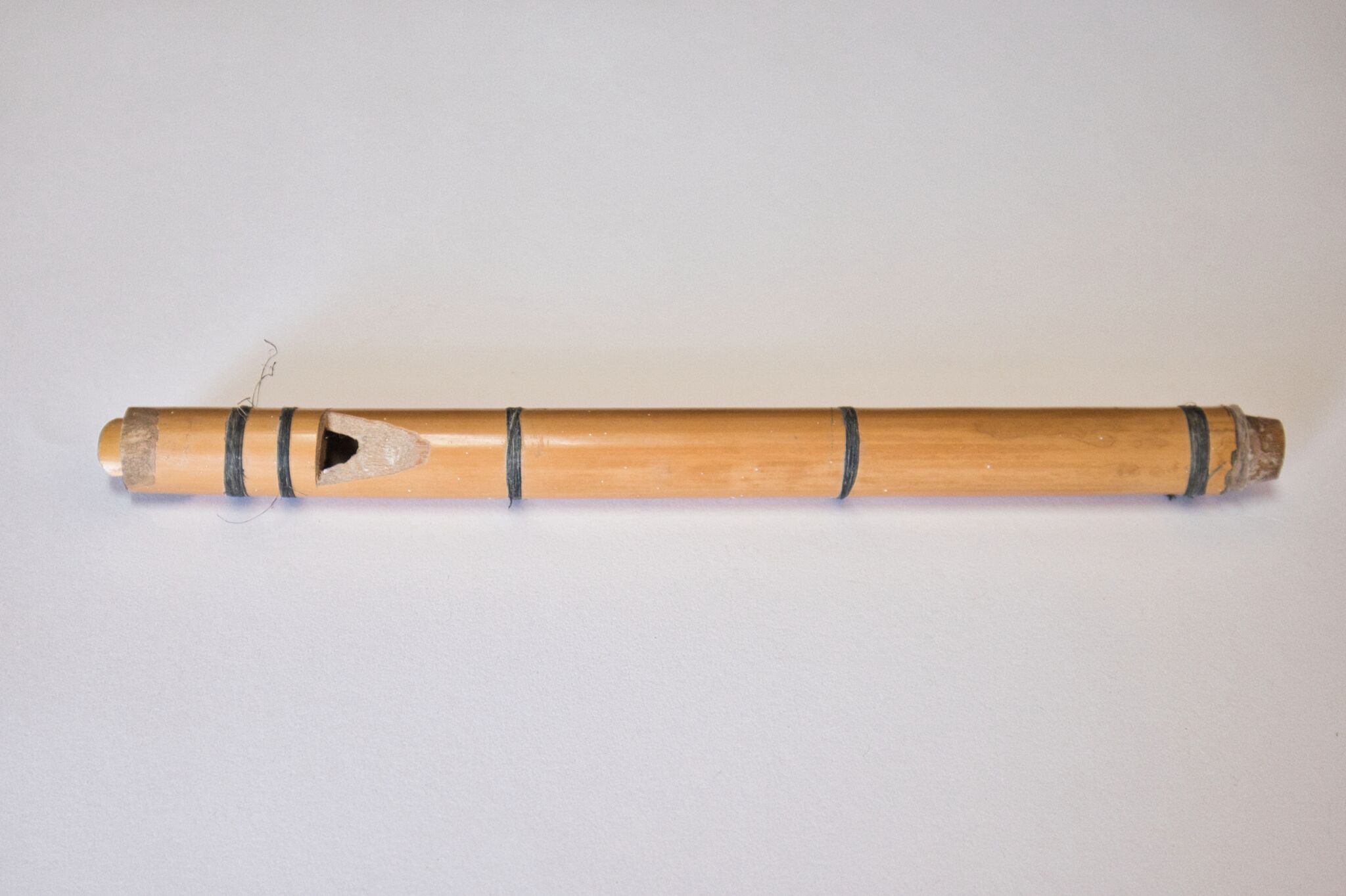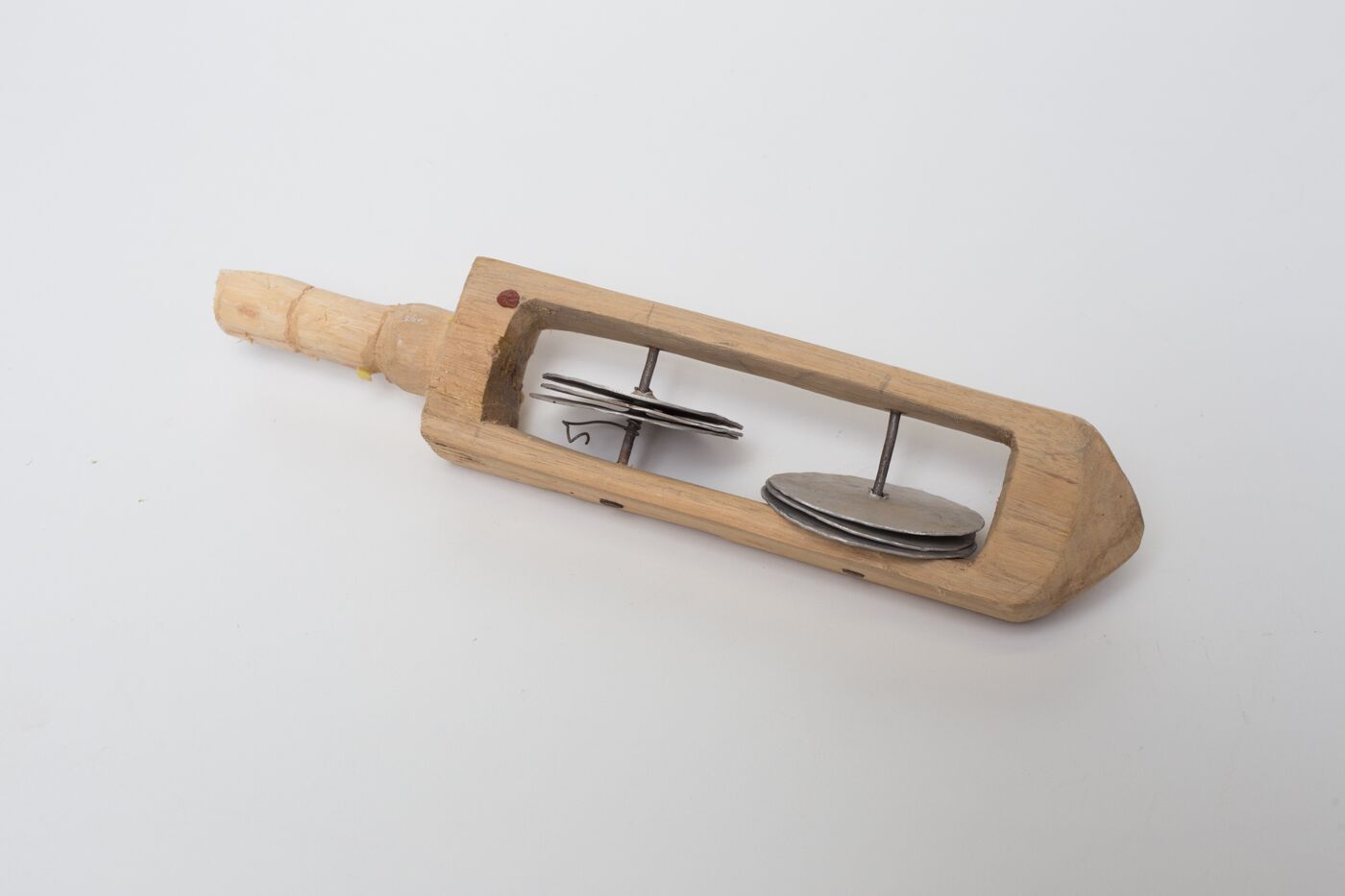-
 Flauta de PascolaDownload
Flauta de PascolaDownload
The Pascola flute is an aerophone musical instrument, made with reed, consisting of two sections of approximately equal length, which fit together in the manner of the European recorder. The upper section, without holes, carries the fistular cut. The mouth of the peak forms the air duct in the form of a small hole. The second section completes the tube of the flute and houses three holes: two on the front face that are occluded respectively with the middle and ring fingers, and another on the back face, to be occluded with the thumb. Between the holes and the lower end of the tube there is a reed knot, which completely closes it. Each section carries six ties of animal sinew, nylon or hemp, spaced unevenly. According to popular myth, the flute represents the viper known as Sikkucha'a (coralillo), who keeps the male goat enchanted through its sound; when we see the Pascola dance, we are really seeing the male goat that dances to the viper. Pascola's flute sounds are markedly descriptive. They try to imitate the chirping of birds, the howling of the wind, the running of water, the playing of rabbits, the howling of coyotes, the slithering of snakes and many other voices of nature. Therefore, it is stated that the music of this flute has a totally festive purpose. Its performer is the tamp'aleo (drummer), who strikes the drum with his little hand or drumstick in his right hand, while playing the flute with his left, accompanying the Pascola in his dance with the Deer (Varela, 1986). There are no indications of the existence of autochthonous Yaqui flutes, but neither can it be confirmed that they were completely lacking. No traces of two-piece pre-Columbian flutes have been found in America. The most logical thing to assume is that the Yaqui flute is an evolved model, following the European one, or a substitute for the original aerophone instrument, if there was one.
Metadata
Title
Flute
Alternative title
Kusia
Creator
Yaqui tribe
Created
2008
Description
Original object (physical):
Dimensions: 24.5 X 2.2 X 2.2 cm.
Wood technique (reed)
Description
The Pascola flute is an aerophone musical instrument, made with reed, consisting of two sections of approximately equal length, which fit together in the manner of the European recorder. The upper section, without holes, carries the fistular cut. The mouth of the peak forms the air duct in the form of a small hole. The second section completes the tube of the flute and houses three holes: two on the front face that are occluded respectively with the middle and ring fingers, and another on the back face, to be occluded with the thumb. Between the holes and the lower end of the tube there is a reed knot, which completely closes it. Each section carries six ties of animal sinew, nylon or hemp, spaced unevenly.
According to popular myth, the flute represents the viper known as Sikkucha'a (coralillo), who keeps the male goat enchanted through its sound; when we see the Pascola dance, we are really seeing the male goat that dances to the viper. Pascola's flute sounds are markedly descriptive. They try to imitate the chirping of birds, the howling of the wind, the running of water, the playing of rabbits, the howling of coyotes, the slithering of snakes and many other voices of nature. Therefore, it is stated that the music of this flute has a totally festive purpose. Its performer is the tamp'aleo (drummer), who strikes the drum with his little hand or drumstick in his right hand, while playing the flute with his left, accompanying the Pascola in his dance with the Deer (Varela, 1986).
There are no indications of the existence of autochthonous Yaqui flutes, but neither can it be confirmed that they were completely lacking. No traces of two-piece pre-Columbian flutes have been found in America. The most logical thing to assume is that the Yaqui flute is an evolved model, following the European one, or a substitute for the original aerophone instrument, if there was one.
Subject
Musical instruments--Mexico--Ethnic groups | Religion and culture--Sonora (Mexico : State)--Holy Week | Religious dance--Mexico
Format
Still image / jpg
Spatial
Sonora , Cócorit
Temporal
2001 - 2010
Is part of
Music and dance room, Museum of the Yaqui people
Provenance
Museum of the Yaqui people. Sinaloa and Obregon No. 200, Cocorit, Cajeme, Sonora
Acquired for the reopening of the museum in the town of Cócorit. It is exhibited in the traditional festival room of the Museum.
Language
eng , yaqui
Date
2021-09-22
Identifier
Web Catalogación Obregón 2016 - 2680
ISC-CGPC-MY-0012
RS-OM-MEY-12
Relationship
Pascola Mask | Violin | Harp | Pascola Drum | Moth Cocoon Ankle Rattles Pascola Length | Pascola dancer hand rattle | Deer dancer | Pascola dancer
References
Varela-Ruiz, Leticia T. (1986). La música en la vida de los yaquis . Sonora: Secretaría de Fomento Educativo y Cultura
Contributor
Sonoran Institute of Culture
Casanova, Juan (photography)
Buitimea Flores, Teodoro; Ruiz Félix, José María (investigation)
Valencia, Carlos ; The Yaqui Pride Project (translation to english)
License

This work is licensed under a Creative Commons Attribution-NonCommercial-ShareAlike 4.0 International License.
Rights
Sonoran Institute of Culture



